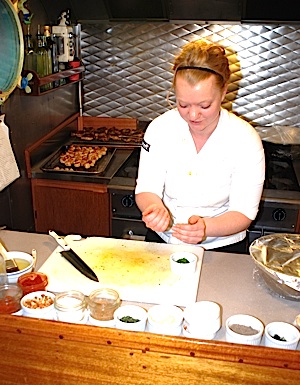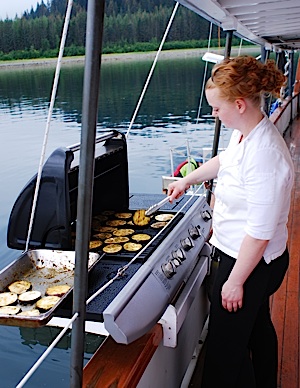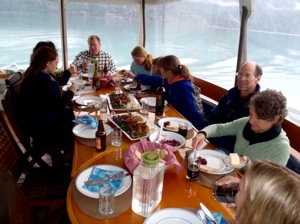Shiny silver on the outside, the cauldron's contents were a delicious contrast of bright orange.
With carapaces large as dinner plates and legs and claws folded to their sides, the Dungeness crabs were freshly steamed and stacked high. Dinner on the Sea Wolf was served. With two empty silver pails bookending the main course, it didn't take long for us to dig in.
At Glacier Bay National Park and Preserve, a seafood dinner doesn't get much fresher.
Angelica Lenning, captain of the Sea Wolf's kitchen, had pulled the crabs, live at the time, from a barrel submerged dockside at Gustavus where a local crabber had left them for her. Also coming aboard with the 10 passengers and the crabs to be stowed in a walk-in cooler below decks were fresh lettuces and vegetables that had been pulled earlier that day from a garden in Gustavus, and other ingredients -- all of the Sea Wolf's menus are designed around local organic seafoods, meats, and fresh vegetables -- for meals that would headline Seattle restaurant menus.
Though the week-long passage up Glacier Bay on the 97-foot ship was billed as an opportunity to explore the expansive national park on foot and by kayak, Chef Lenning was going to ensure we would have a delicious way to replace our spent calories.
Eating Healthier In National Parks
Across the National Park System more and more concessionaires are paying attention to the quality of the meals they offer. Sure, you still can find greasy burgers, fries, fried chicken, and deep-fried dishes that will send your cholesterol levels through the lodge roof. But executive chefs are decidedly more selective of healthy, sustainable ingredients, be they farm-raised bison, heirloom tomatoes, or seafood approved by the Monterey Bay Aquarium staff.

Chef Lenning at work on dinner. Kurt Repanshek photo.
Aboard the Sea Wolf, Chef Lenning doesn't have the sous staff that can be found in the kitchens in Yellowstone, the Grand Canyon, or Shenandoah, which might be why she is in her kitchen at 6:30 a.m. to have breakfast on the table by 8 a.m., and why she returns at 3:30 p.m. to start dinner.
But her kitchen would make most homeowners envious. There's a commerical-quality, six-burner Imperial Green Tech stove and a range, knives and spices within reach, even a propane-fired barbecue grill mounted to an outside deck railing.
Of course, without her creativity, it would go for naught. Trained at the Ballymaloe Cookery School in Cork, Ireland, and with added experience steeped from the Seattle restaurant scene, the chef is well-prepared for just about anything that might go wrong.
The three-month program at Ballymaloe was a culinary bootcamp. Classes went from 7 a.m. until 6 p.m. five days a week, with lectures, cooking demonstrations, and cooking herself. Situated on a 100-acre organic farm, the school also required students to go out and get first-hand knowledge of their ingredients -- whether it was beef still on the hoof, cackling chickens, squealing pigs, or row after row of gardens in greenhouses. Students visit artisan cheesemakers, study food safey, and take wine courses so they won't botch pairings with their meals.
"They show you how to do it, they give you an opportunity to try, and an opportunity to improve," Chef Lenning recalled while chopping herbs to flavor a lamb and scallop dinner. "You either have it, or you don't."
The final test was preparing a three-course meal, with wine pairings, in a set amount of time. She passed.
From Ireland, the chef went into the kitchen of a lodge on the north shore of Lake Superior, then on to Seattle where she worked at The Ruins, a private dining club. Then Kimber Owen, owner and captain of the Sea Wolf, offered the chef her own floating restaurant.

A grill mounted on the ship's railing saw plenty of use during the week. Here Chef Lenning grills eggplant. Kurt Repanshek photo.
"I wanted it to be real high quality and interesting, without being too pretentious," Chef Lenning said in explaining how she works during the off-season to prepare a rotation of week-long menus for guests. "Generally it's on a three-week rotation, so 63 meals. And then all the breads and things."
A Wonderful Variety of Meals
Seafood understandably surfaces frequently as a main dish, but Chef Lenning also turns to chicken and lamb. Last summer she employed some Spanish and Indian influences via garlic, ginger, cayenne, tumeric, corriander, and fennel along with the usual salt and pepper.
While the Dungeness crab was the centerpiece one night, another featured a mixed grill of lamb chops and scallops with an apricot chutney, couscous with almonds, and a grilled romaine salad. Chicken, with a mysterious, but delicious, Swedish spice, was somewhat of a challenge for the chef, as the oven malfunctioned -- something she never announced -- and she had to cook it on the grill balanced over the icy waters of Glacier Bay. Flatbreads also made frequent appearances during our trip due to the recalcitrant oven.
Chef Lenning's creativity surfaced time and again. Leftover Dungeness crab from that first night's meal didn't go to waste, reappearing in salads and a sumptuous crab bisque. Salmon caught the day before we left Gustavus by four of our fellow passengers became a main course. So did black cod, which came atop garlic mashed potatoes with kale, carrots, and Foccacia. One night romaine lettuce that the chef grilled with a view of the bay found its way to the dinner table.
If you wanted to ward off the calories of breakfast blintzes, there was fresh-made granola, hard-boiled eggs, oatmeal, toasts, and fresh fruit. Cottage cheese and pitted cherries, not whipped cream or cream cheese, sidled up to crepes.

Dinner time not only gave us a chance to replenish calories, but to discuss the day's events. Kurt Repanshek photo.
Lunches always were imaginative, as evidence by the crab bisque, a potato soup with brown butter and croutons, and rosemary bread. Another day the soup was carrot with cumin topped by a dollop of freshly whipped cream, and poire bread.
Throughout the day the ever-present bowl of bananas, apples, pears, oranges and Clementines waited for you, and the coffee and hot water for tea were there, as well, to ward off the sea breeze.
Calories were hard to avoid when desserts such as chocolate halzenut torte with cabernet sauce turned up. If anything, the meals were encouragement to work harder paddling or hiking during the day. But it was difficult to say if we were really trying to burn off the calories or simply looking to make the clock spin faster between meals.
The last dinner? Why, it ended with Baked Alaska, of course.




 Support Essential Coverage of Essential Places
Support Essential Coverage of Essential Places







Add comment